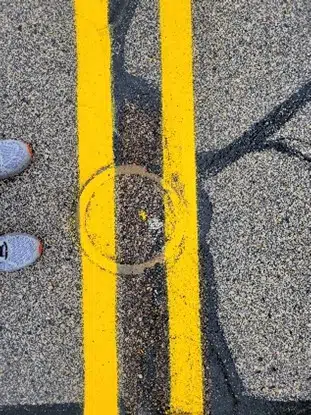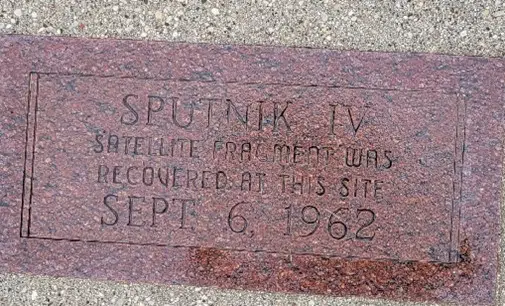
On the left Officer Marvin Bauch and the right Officer Ronald Rusboldt stand in the 600 block of North 8th St. at the spot where they discovered the remains of Russian Sputnik IV after it disintegrated at crash to earth 4:49 A.M. September 5, 1962.
The following article was researched and written by Jeff Seidl.
While on squad car patrol September 5, 1962, at 5:45 A.M. Officers Marvin Bauch and Ronald Rusboldt spotted what they thought was crumpled cardboard in the road of the 600 block of N. 8th Street. While passing the area again at 6:45 A.M. the object was still there, and they could see it was metal and stopped to move it. It was too hot to handle, so they used their feet to shove it to the curb. At the time, they thought it was slag from one of the local foundries which had fallen off the truck on the way to disposal. Passing the area again at 8:00 A.M., they stopped again and looked at the metal and it was still warm1.
The two officers didn’t know it at the time but the 20-pound piece they found was actually part of Russian Sputnik IV which had broken apart and crashed.
At noon, the department learned that space observers were asking for reports of finding of any chunks of the disintegrated satellite. Officers picked it up and brought it to police headquarters.
The Fire Department checked the metal using a Geiger Counter but no radioactivity was found1.
Police Inspector Francis Lallensack, called Manitowoc Shipbuilding Company for assistance in contacting a metal expert. By chance, a metallurgist from a Chicago company was in the office and agreed to look at the piece. In examining the piece, he determined that it was high- temperature-resistant steel with less stable steel behind it. He also theorized that the steel came from the nose cone of a rocket or a missile1.
The Chicago metallurgist took the metal with him and turned it over to Ed Hallaback the director of the Milwaukee Astronomical Society1. After examination by other experts, it was decided to send the burned metal to the Smithsonian Institute for further tests by government agencies and space authorities1.
But the satellite was seen as it made its nosedive to earth. The search for falling debris was started when members of the Milwaukee Astronomical Society working on what was later found to be Project Moon Watch3 was watching the Russian Sputnik and saw it break up at about 4:49 A.M.1 The director of the Society, Ed Hallback,3 issued a call for reports on falling bits of the Sputnik and also headed a team, commissioned by the Smithsonian, to track the re-entry of the satellite.

The Sputnik landing has left a permanent mark on the roadway
Police in Eagle River, WI reported seeing multiple flaming pieces flash across the sky at 4:49 A.M. The U. S. Air Force reported sightings by people in Nebraska and Minnesota. Two people from Kellnersville, WI, (Manitowoc County) reported seeing Sputnik. At approximately 4:50 A.M. they could see a small fireball coming towards them. The fireball grew in size and assumed a variety of colors and they noticed a line of five objects headed for Manitowoc1.
The family living at the parsonage of First Lutheran Church which is located about 150 ft. from the spot where the officers found the object, discover a fragment lying in the middle of the lawn at the parsonage and turn it over to police2.
Walter Munn2 a representative for the Smithsonian and whose current job is the Moonwatch Satellite Tracking Program3, was to travel to Manitowoc to question those who sighted the break up of the Sputnik and to track its course2. After his arrival, he began his investigation and located a fragment presumed to be from Sputnik atop the roof of First Lutheran Church and another 15-20 other fragments as far as 700 feet from the scene of the original find3
There was a question about the matter being a hoax and during a news conference Munn laid a ruler on a map with dots showing all the reported sightings. He placed a ruler along the dots and it came right through Manitowoc, discounting the idea of a hoax3. It was at this press conference that the first request was made if the remains of the Sputnik could be returned to Manitowoc for permanent exhibit in the Manitowoc Museum. A this point Munn stated he would recommend a replica cast be made and presented to Manitowoc3.
Three divers who represented the Milwaukee Astronomical Society and Project Moonwatch dove the Manitowoc Harbor in search of more fragments3. However, because of heavy rains the night before they had poor visibility despite the fact they were using underwater lights. The divers were then towed behind the police boat as they felt along the bottom but found nothing3.
They also moved out into Lake Michigan south of the break water3. Munn explained that the Smithsonian was interested in small fragments but were hoping for larger pieces so they could determine the structure of the craft. Nothing was located in Lake Michigan.
As an interesting side note, due to heavy seas in the harbor while towing the divers behind the boat, a large wave partially swamped the rear of the police boat. The officer piloting the boat signaled the divers to come in and fired a distress flare. The Lade* Fish tug came to their aide and towed the police boat to its shed3.
Munn continued his investigation going to Milwaukee to talk with Ed Hallbach who is in charge of Milwaukee Moonwatch program who first spotted the break up3. He then traveled to Eagle River, Green Bay and Eau Claire to check with those who sighted the fragments in the sky3.
As the investigation and news reports continued, citizens from both the City, County and Two Rivers started to bring in metal they found on their property as possible pieces of the sputnik3.
These pieces were saved to be turned over to Smithsonian investigators.
A newspaper story on September 11, 1962 states that scientists at Los Almos, New Mexico and scientists at the Smithsonian confirm the belief that the 20 pound piece found in
 Manitowoc is part of Sputnik4. This was the first official opinion to confirm the belief that the metal found in Manitowoc was part of Sputnik4.
Manitowoc is part of Sputnik4. This was the first official opinion to confirm the belief that the metal found in Manitowoc was part of Sputnik4.
A newspaper article September 13, 1962 confirmed that the metal found by the Manitowoc police officers was definitely proven to be from Sputnik and the metal was on its way back to
the Russians5. However, the same article stated there was a debate between U. S. government agencies as to the exact disposition of the piece5. One day later a newspaper article on September 14 states, a marine construction worker turned over a 7 ½ pound piece of material found near the carferry dock and south breakwater8.
During the Sputnik investigation Milwaukee6 made claim to have the remains of the Sputnik returned to them. The City of Manitowoc made several requests during the investigation requesting the return of the Sputnik to the City including a formal resolution by the Common Council requesting the return6. However, the article noted that the 20 pound piece had been cut up and reduced in size during research on the metal.
Copies of the resolution were sent to President John F. Kennedy, U. S. Senator Alexander Wiley and U.S. Senator William Proxmire, and Congressman John W. Byrnes, NASA and the Smithsonian. The original resolution also designated September 5 be set aside as Areo Space Day in Manitowoc. However, during the discussion on this topic this idea was dropped15.
The U. S. State Department settles the disagreement of who gets the remains of Sputnik. between Manitowoc and Milwaukee. In October 1962, it was decided that both Manitowoc and Milwaukee will both get replicas of what is now a 14 pound section9.
Milwaukee laid claim to the metal because their Astronomical Society assisted in the identification of the craft and Manitowoc wanted the metal because it landed there.
A January 1963 article states that the Russians who made a big deal on refusing the return of the Sputnik have quietly taken possession of the metal that was offered to them September, 196210.
In September 1963, the Manitowoc Common Council creates a resolution and votes to accept not one but two replicas of Sputnik. One from Congressman John Brynes and one from Senator William Proxmire. One of the replicas will go for display to the Rahr Museum and the other for display at the Manitowoc Police Department11.
So why a resolution to accept the replica? The newspaper article stated that an alderman pointed out that one year earlier the council voted not to accept any replica of the sputnik.
In order to accept a replica they would have to take action to amend that position11.
In October 1963, the International Machinists Association working with the Manitowoc Engineering Company receive permission from the City of Manitowoc to permanently mark the spot where the Sputnik landed with a metal ring12.
In October of 1963, the Rahr Museum announces in the paper that the replica of Sputnik IV may be viewed at the museum13&14. Today, the Rahr Museum is now the Rahr West Museum and Mansion. In front of the Rahr West Museum and Mansion the ring is still in the street 53 feet north of Park St. There is also a granite marker along the curb.












